Graft Pre-conditioning by Peri-Operative Perfusion of Kidney Allografts With Rabbit Anti-human T-lymphocyte Globulin Results in Improved Kidney Graft Function in the Early Post-transplantation Period-a Prospective, Randomized Placebo-Controlled Trial
- PMID: 30197644
- PMCID: PMC6117415
- DOI: 10.3389/fimmu.2018.01911
Graft Pre-conditioning by Peri-Operative Perfusion of Kidney Allografts With Rabbit Anti-human T-lymphocyte Globulin Results in Improved Kidney Graft Function in the Early Post-transplantation Period-a Prospective, Randomized Placebo-Controlled Trial
Abstract
Introduction: Although prone to a higher degree of ischemia reperfusion injury (IRI), the use of extended criteria donor (ECD) organs has become reality in transplantation. We therefore postulated that peri-operative perfusion of renal transplants with anti-human T-lymphocyte globulin (ATLG) ameliorates IRI and results in improved graft function. Methods: We performed a randomized, single-blinded, placebo-controlled trial involving 50 kidneys (KTx). Prior to implantation organs were perfused and incubated with ATLG (AP) (n = 24 kidney). Control organs (CP) were perfused with saline only (n = 26 kidney). Primary endpoint was defined as graft function reflected by serum creatinine at day 7 post transplantation (post-tx). Results: AP-KTx recipients illustrated significantly better graft function at day 7 post-tx as reflected by lower creatinine levels, whereas no treatment effect was observed after 12 months surveillance. During the early hospitalization phase, 16 of the 26 CP-KTx patients required dialysis during the first 7 days post-tx, whereas only 10 of the 24 AP-KTx patients underwent dialysis. No treatment-specific differences were detected for various lymphocytes subsets in the peripheral blood of patients. Additionally, mRNA analysis of 0-h biopsies post incubation with ATLG revealed no changes of intragraft inflammatory expression patterns between AP and CP organs. Conclusion: We here present the first clinical study on peri-operative organ perfusion with ATLG illustrating improved graft function in the early period post kidney transplantation. Clinical Trial Registration: www.ClinicalTrials.gov, NCT03377283.
Keywords: ATLG; RCT; ischemia reperfusion injury; kidney transplantation; organ preservation.
Figures
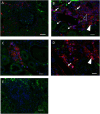


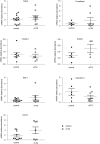

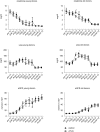
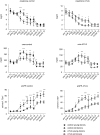
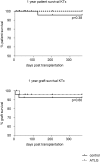
Similar articles
-
Perioperative Perfusion of Allografts with Anti-Human T-lymphocyte Globulin Does Not Improve Outcome Post Liver Transplantation-A Randomized Placebo-Controlled Trial.J Clin Med. 2021 Jun 25;10(13):2816. doi: 10.3390/jcm10132816. J Clin Med. 2021. PMID: 34202355 Free PMC article.
-
Efficacy of two different doses of rabbit anti-T-lymphocyte globulin to prevent graft-versus-host disease in children with haematological malignancies transplanted from an unrelated donor: a multicentre, randomised, open-label, phase 3 trial.Lancet Oncol. 2017 Aug;18(8):1126-1136. doi: 10.1016/S1470-2045(17)30417-5. Epub 2017 Jul 10. Lancet Oncol. 2017. PMID: 28705454 Clinical Trial.
-
Effects of cyclosporine A pretreatment of deceased organ donors on kidney graft function (Cis-A-rein): study protocol for a randomized controlled trial.Trials. 2018 Apr 17;19(1):231. doi: 10.1186/s13063-018-2597-4. Trials. 2018. PMID: 29665840 Free PMC article.
-
Thymoglobulin and ischemia reperfusion injury in kidney and liver transplantation.Nephrol Dial Transplant. 2007 Sep;22 Suppl 8:viii54-viii60. doi: 10.1093/ndt/gfm651. Nephrol Dial Transplant. 2007. PMID: 17890265 Review.
-
Delayed graft function and its management in children.Pediatr Nephrol. 2017 Jul;32(7):1157-1167. doi: 10.1007/s00467-016-3528-9. Epub 2016 Oct 24. Pediatr Nephrol. 2017. PMID: 27778091 Review.
Cited by
-
Perioperative Perfusion of Allografts with Anti-Human T-lymphocyte Globulin Does Not Improve Outcome Post Liver Transplantation-A Randomized Placebo-Controlled Trial.J Clin Med. 2021 Jun 25;10(13):2816. doi: 10.3390/jcm10132816. J Clin Med. 2021. PMID: 34202355 Free PMC article.
-
Machine Perfusion of Extended Criteria Donor Organs: Immunological Aspects.Front Immunol. 2020 Feb 27;11:192. doi: 10.3389/fimmu.2020.00192. eCollection 2020. Front Immunol. 2020. PMID: 32180769 Free PMC article. Review.
-
Review: Ischemia Reperfusion Injury-A Translational Perspective in Organ Transplantation.Int J Mol Sci. 2020 Nov 13;21(22):8549. doi: 10.3390/ijms21228549. Int J Mol Sci. 2020. PMID: 33202744 Free PMC article. Review.
-
Impact of Organ Donor Pretreatment With Anti-Thymocyte Globulin in a Murine Model of Allogenic Kidney Transplantation.Transpl Int. 2025 Jan 7;37:13997. doi: 10.3389/ti.2024.13997. eCollection 2024. Transpl Int. 2025. PMID: 39839912 Free PMC article.
-
Expression of MICA in Zero Hour Biopsies Predicts Graft Survival After Liver Transplantation.Front Immunol. 2021 Jul 20;12:606146. doi: 10.3389/fimmu.2021.606146. eCollection 2021. Front Immunol. 2021. PMID: 34354697 Free PMC article.
References
-
- Compagnon P, Levesque E, Hentati H, Disabato M, Calderaro J, Feray C, et al. . An oxygenated and transportable machine perfusion system fully rescues liver grafts exposed to lethal ischemic damage in a pig model of DCD liver transplantation. Transplantation (2017) 101:e205–13. 10.1097/TP.0000000000001764 - DOI - PubMed
Publication types
MeSH terms
Substances
Associated data
LinkOut - more resources
Full Text Sources
Other Literature Sources
Medical
Miscellaneous

